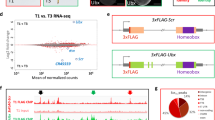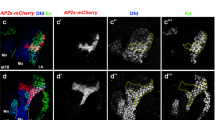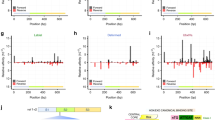Abstract
Hox proteins control genetic programs that orchestrate development, and a large subset of Hox proteins can bind DNA elements as heterodimers with the Pbx family of homeodomain proteins. A transcriptionally activated version of Pbx1, E2a-Pbx1, is an oncoprotein in human pre-B cell leukemia that strongly suppresses differentiation and retains its ability to heterodimerize with Hox proteins. Because monomeric Hox proteins bind very similar DNA motifs, it is unclear how they activate diverse developmental programs. Here we demonstrate that heterodimers containing different Hox proteins and a common Pbx1 or E2a-Pbx1 partner bind different DNA motifs. Structural models suggest that the specificity of the Hox protein is altered by a conformation change involving residues in the N-terminal arm of the Hox homeodomain. Mutational analysis also supported the hypothesis that unique sequences in the N-terminal arm of the Hox homeodomain are at least partially responsible for mediating this specificity. In vivo, Hox proteins directed E2a-Pbx1-mediated transactivation with moderate specificity to cognate Hox-Pbx motifs. Thus, the development specificity of individual Hox proteins may be mediated, in part, by differential targeting of cellular genes by Pbx1-Hox complexes. Likewise, through its function as a common heterodimer partner, oncoprotein E2a-Pbx1 may be able to interfere with multiple programs of development that are induced by the sequential or simultaneous expression of Hox proteins during hematopoiesis.
This is a preview of subscription content, access via your institution
Access options
Subscribe to this journal
Receive 50 print issues and online access
$259.00 per year
only $5.18 per issue
Buy this article
- Purchase on Springer Link
- Instant access to full article PDF
Prices may be subject to local taxes which are calculated during checkout
Similar content being viewed by others
Author information
Authors and Affiliations
Rights and permissions
About this article
Cite this article
Lu, Q., Kamps, M. Heterodimerization of Hox proteins with Pbx1 and oncoprotein E2a-Pbx1 generates unique DNA-binding specificities at nucleotides predicted to contact the N-terminal arm of the Hox homeodomain – demonstration of Hox-dependent targeting of E2a-Pbx1 in vivo. Oncogene 14, 75–83 (1997). https://doi.org/10.1038/sj.onc.1200799
Received:
Revised:
Accepted:
Issue Date:
DOI: https://doi.org/10.1038/sj.onc.1200799
Keywords
This article is cited by
-
Spindle function and Wnt pathway inhibition by PBX1 to suppress tumor progression via downregulating DCDC2 in colorectal cancer
Oncogenesis (2023)
-
Histone acetyl transferase GCN5 promotes human hepatocellular carcinoma progression by enhancing AIB1 expression
Cell & Bioscience (2016)
-
KATs in cancer: functions and therapies
Oncogene (2015)
-
Childhood B-acute lymphoblastic leukemia: a genetic update
Experimental Hematology & Oncology (2014)
-
The Hox genes and their roles in oncogenesis
Nature Reviews Cancer (2010)



